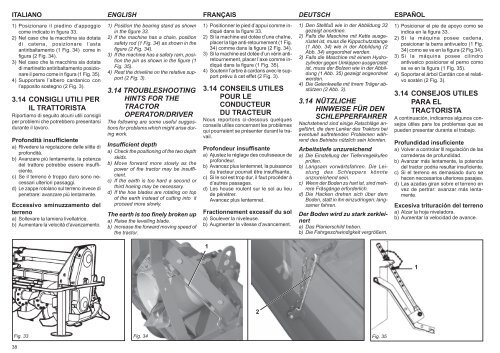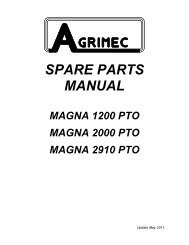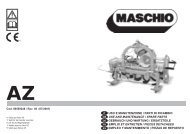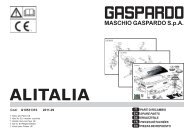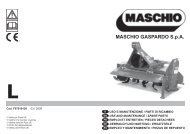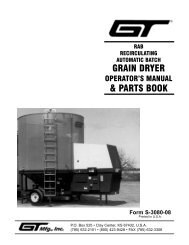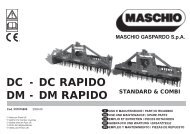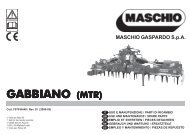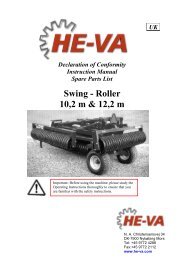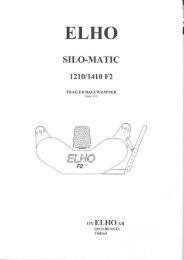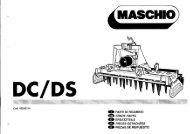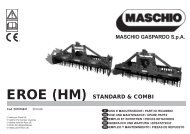MASCHIO GASPARDO S.p.A. - Opico
MASCHIO GASPARDO S.p.A. - Opico
MASCHIO GASPARDO S.p.A. - Opico
You also want an ePaper? Increase the reach of your titles
YUMPU automatically turns print PDFs into web optimized ePapers that Google loves.
ITALIANO<br />
1) Posizionare il piedino d’appoggio<br />
come indicato in figura 33.<br />
2) Nel caso che la macchina sia dotata<br />
di catena, posizionare l’asta<br />
antiribaltamento (1 Fig. 34) come in<br />
figura (2 Fig. 34).<br />
3) Nel caso che la macchina sia dotata<br />
di martinetto antiribaltamento posizionare<br />
il perno come in figura (1 Fig. 35).<br />
4) Supportare l’albero cardanico con<br />
l’apposito sostegno (2 Fig. 3).<br />
3.14 CONSIGLI UTILI PER<br />
IL TRATTORISTA<br />
Riportiamo di seguito alcuni utili consigli<br />
per problemi che potrebbero presentarsi<br />
durante il lavoro.<br />
Profondità insufficiente<br />
a) Rivedere la regolazione delle slitte di<br />
profondità.<br />
b) Avanzare più lentamente, la potenza<br />
del trattore potrebbe essere insufficiente.<br />
c) Se il terreno è troppo duro sono necessari<br />
ulteriori passaggi.<br />
d) Le zappe rotolano sul terreno invece di<br />
penetrare: avanzare più lentamente.<br />
Eccessivo sminuzzamento del<br />
terreno<br />
a) Sollevare la lamiera livellatrice.<br />
b) Aumentare la velocità d’avanzamento.<br />
ENGLISH FRANÇAIS DEUTSCH<br />
ESPAÑOL<br />
1) Position the bearing stand as shown<br />
in the figure 33.<br />
2) If the machine has a chain, position<br />
safety rod (1 Fig. 34) as shown in the<br />
figure (2 Fig. 34).<br />
3) If the machine has a safety ram, position<br />
the pin as shown in the figure (1<br />
Fig. 35).<br />
4) Rest the driveline on the relative support<br />
(2 Fig. 3).<br />
3.14 TROUBLESHOOTING<br />
HINTS FOR THE<br />
TRACTOR<br />
OPERATOR/DRIVER<br />
The following are some useful suggestions<br />
for problems which might arise during<br />
work.<br />
Insufficient depth<br />
a) Check the positioning of the two depth<br />
skids.<br />
b) Move forward more slowly as the<br />
power of the tractor may be insufficient.<br />
c) If the earth is too hard a second or<br />
third hoeing may be necessary.<br />
d) If the hoe blades are rotating on top<br />
of the earth instead of cutting into it<br />
proceed more slowly.<br />
The earth is too finely broken up<br />
a) Raise the levelling blade.<br />
b) Increase the forward moving speed of<br />
the tractor.<br />
1) Positionner le pied d’appui comme indiqué<br />
dans la figure 33.<br />
2) Si la machine est dotée d’une chaîne,<br />
placer la tige anti-retournement (1 Fig.<br />
34) comme dans la figure (2 Fig. 34).<br />
3) Si la machine est dotée d’un vérin antiretournement,<br />
placer l’axe comme indiqué<br />
dans la figure (1 Fig. 35).<br />
4) Soutenir l’arbre à cardans avec le support<br />
prévu à cet effet (2 Fig. 3).<br />
3.14 CONSEILS UTILES<br />
POUR LE<br />
CONDUCTEUR<br />
DU TRACTEUR<br />
Nous reportons ci-dessous quelques<br />
conseils utiles concernant les problèmes<br />
qui pourraient se présenter durant le travail.<br />
Profondeur insuffisante<br />
a) Ajustez le réglage des coulisseaux de<br />
profondeur.<br />
b) Avancez plus lentemnet, la puissance<br />
du tracteur pourrait être insuffisante.<br />
c) Si le sol est trop dur, il faut procéder à<br />
d’autres passages.<br />
d) Les house roulent sur le sol au lieu<br />
de pénétrer.<br />
Avancez plus lentemnet.<br />
Fractionnement excessif du sol<br />
a) Soulever la niveleuse.<br />
b) Augmenter la vitesse d’avancement.<br />
1) Den Stellfuß wie in der Abbildung 33<br />
gezeigt anordnen.<br />
2) Falls die Maschine mit Kette ausgerüstet<br />
ist, muss die Kippschutzstange<br />
(1 Abb. 34) wie in der Abbildung (2<br />
Abb. 34) angeordnet werden.<br />
3) Falls die Maschine mit einem Hydrozylinder<br />
gegen Umkippen ausgerüstet<br />
ist, muss der Bolzen wie in der Abbildung<br />
(1 Abb. 35) gezeigt angeordnet<br />
werden.<br />
4) Die Gelenkwelle mit ihrem Träger abstützen<br />
(2 Abb. 3).<br />
3.14 NÜTZLICHE<br />
HINWEISE FÜR DEN<br />
SCHLEPPERFAHRER<br />
Nachstehend sind einige Ratschläge angeführt,<br />
die dem Lenker des Traktors bei<br />
eventuell auftretenden Problemen während<br />
des Betriebs nützlich sein könnten.<br />
Arbeitstiefe unzureichend<br />
a) Die Einstellung der Tiefenregelkufen<br />
prüfen.<br />
b) Langsam vorwärtsfahren. Die Leistung<br />
des Schleppers könnte<br />
unzrureichend sein.<br />
c) Wenn der Boden zu hart ist, sind mehrere<br />
Fräsgänge erforderlich.<br />
d) Die Hacken drehen sich über dem<br />
Boden, statt in ihn einzudringen: langsamer<br />
fahren.<br />
Der Boden wird zu stark zerkleinert<br />
a) Das Planierschild heben.<br />
b) Die Fahrgeschwindigkeit vergrößern.<br />
1) Posicionar el pie de apoyo como se<br />
indica en la figura 33.<br />
2) Si la máquina posee cadena,<br />
posicionar la barra antivuelco (1 Fig.<br />
34) como se ve en la figura (2 Fig.34).<br />
3) Si la máquina posee cilindro<br />
antivuelco posicionar el perno como<br />
se ve en la figura (1 Fig. 35).<br />
4) Soportar el árbol Cardán con el relativo<br />
sostén (2 Fig. 3).<br />
3.14 CONSEJOS UTILES<br />
PARA EL<br />
TRACTORISTA<br />
A continuación, indicamos algunos consejos<br />
útiles para los problemas que se<br />
pueden presentar durante el trabajo.<br />
Profundidad insuficiente<br />
a) Volver a controlar lll regulación de las<br />
correderas de profundidad.<br />
b) Avanzar más lentamente, la potencia<br />
del tractor podria resultar insuficiente.<br />
c) Si el terreno es demasiado duro se<br />
hacen neccesarios ulteriores pasajes.<br />
d) Las azadas giran sobre el terreno en<br />
vez de pertrar: avanzar más lentamente.<br />
Excesiva trituración del terreno<br />
a) Alzar la hoja niveladora.<br />
b) Aumentar la velocidad de avance.<br />
1<br />
1<br />
2<br />
Fig. 33 Fig. 34<br />
Fig. 35<br />
38


